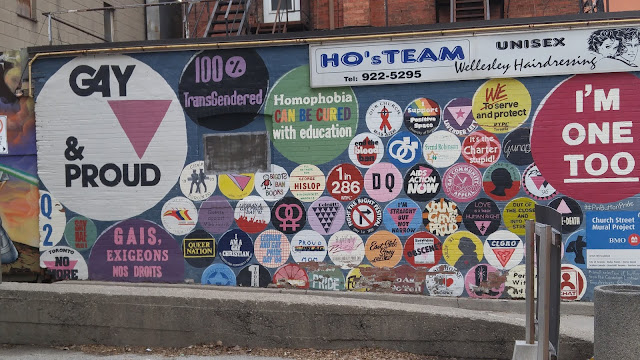When I started researching into transgender history, I was frequently tripping over the language used in the articles I would find. The term “transsexual” kept coming up. As a transgender woman that came of age in the mid to late 2010s, transsexual was out of vogue, frequently with negative connotations. It was not until I read Susan Stryker’s “Transgender History” that I discovered that this has not always been the case.
Transgender language evolved quickly. Even the terms used as recently as a decade ago have been abandoned by the community, and so many are unaware of this phenomenon. Phrases like “transgendered” are viewed with skepticism, representing an ignorance of transgender issues from those that use it nowadays. But if you walk over to Church St and Wellesley St, you will find a large mural that includes the phrase in the heart of Toronto’s Gay Village.
 |
| The mural at Church and Wellesley. Note the use of "transgendered" in the top left. Photo courtesy of Amelia Smith. |
This presents a problem for museums wishing to talk about transgender history. How do we grapple with this changing language in exhibitions in which even the community is frequently not aware of? Do we use the language viewers are familiar with and apply labels to those that did not choose them or do we keep the original language, fearing a negative response from the community we are hoping to serve?
As I am sure many of us are aware, when it comes to label writing, we need to be very precise with our wording. In order to keep the visitor’s attention, the labels need to be short and direct. Unfortunately, this does not lend itself to in depth discussions of complex topics, such as the evolution of language. As such, simply explaining the issue in a label may not be the best option.
Additionally, many queer historians consider it problematic to apply labels to those that did not choose them for themselves. Without definite proof, it often becomes inserting modern understandings upon a past that might not have shared them. Identity is so incredibly personal, and to say that we know better than someone else about their identity is arrogant and elitist. Altering how they identify goes against so much of what the transgender community and the LGBT as a whole has fought for.
| This practice of not applying labels to people from previous generations has also long been the target of ridicule by members of the LGBT as well. Photo courtesy of Amelia Smith. |
But, the work should be made for the transgender community as it exists today. As I spoke about in my previous article, transgender people have long been overlooked in museums. Using language that the community deems to be offensive, even if it has a place within the historical context, presents the danger of angering that same community.
I wish I could say that there is an easy solution to this issue, but I do not believe there to be. Each position has its pros and cons. The difficulties that surround presenting an evolving language that is often overlooked cannot be solved so simply and must be significantly considered when writing about transgender history.


No comments:
Post a Comment
Note: only a member of this blog may post a comment.